Neurophysiological and Autonomic Correlates of Metacognitive Control of and Resistance to Distractors in Ecological Setting: A Pilot Study
Abstract
1. Introduction
2. Materials and Methods
2.1. Sample
2.2. Procedure
2.2.1. The Resistance to Ecological Distractors Task (RED Task)
“Today is a particularly busy working day. You ate fast in the cafeteria aware that at 2:00 p.m. you have one last update meeting for a project that needs to be finished within two weeks. Attention: during the meeting, you will listen to, you will have to understand the dialogue and count how many times you hear a sound similar to a notification”.
“Reminder: Recall as soon as possible Roberto Rossi (project manager of the company).”
- (a)
- No doubt it was more important to respond immediately to the call because there was a greater need to speak with the colleague as soon as possible;
- (b)
- It seemed better to me to solve first the question of the pending call and then dedicate myself to the meeting;
- (c)
- Since the reminder had been set at that time, it was important to respect the commitment made;
- (d)
- I reacted spontaneously, without thinking too much about it;
- (e)
- I did not make a choice.
- (a)
- No doubt it was more important to follow the meeting so as not to lose track of the sounds;
- (b)
- If I had answered, I would have lost important information about the project, which needs to be finished soon;
- (c)
- It seemed better to do one thing at a time;
- (d)
- I reacted spontaneously, without thinking too much about it;
- (e)
- I did not make a choice.
2.2.2. Behavioural Data Acquisition
2.2.3. Big Five Inventory: Self-Report Data Acquisition
2.2.4. The MuseTM Headband for Neurophysiological Data Acquisition
2.2.5. The X-Pert2000 Biofeedback for Autonomic Data Acquisition
2.3. Data Analyses
3. Results
4. Discussion
5. Conclusions
Author Contributions
Funding
Institutional Review Board Statement
Informed Consent Statement
Data Availability Statement
Conflicts of Interest
References
- Papadakis, V.M.; Lioukas, S.; Chambers, D. Strategic Decision-Making Processes: The Role of Management and Context. Strateg. Manag. J. 1998, 19, 115–147. [Google Scholar] [CrossRef]
- Pearson, D.; Watson, P.; Albertella, L.; Le Pelley, M.E. Attentional Economics Links Value-Modulated Attentional Capture and Decision-Making. Nat. Rev. Psychol. 2022, 1, 320–333. [Google Scholar] [CrossRef]
- Miller, E.K.; Cohen, J.D. An Integrative Theory of Prefrontal Cortex Function. Annu. Rev. Neurosci. 2001, 24, 167–202. [Google Scholar] [CrossRef] [PubMed]
- Diamond, A. Executive Functions. Annu. Rev. Psychol. 2013, 64, 135–168. [Google Scholar] [CrossRef] [PubMed]
- Miyake, A.; Friedman, N.P. The Nature and Organization of Individual Differences in Executive Functions: Four General Conclusions. Curr. Dir. Psychol. Sci. 2012, 21, 8–14. [Google Scholar] [CrossRef] [PubMed]
- Miyake, A.; Friedman, N.P.; Emerson, M.J.; Witzki, A.H.; Howerter, A. The Unity and Diversity of Executive Functions and Their Contributions to Complex “Frontal Lobe” Tasks: A Latent Variable Analysis. Cogn. Psychol. 2000, 41, 49–100. [Google Scholar] [CrossRef]
- Friedman, N.P.; Miyake, A.; Young, S.E.; DeFries, J.C.; Corley, R.P.; Hewitt, J.K. Individual Differences in Executive Functions Are Almost Entirely Genetic in Origin. J. Exp. Psychol. Gen. 2008, 137, 201–225. [Google Scholar] [CrossRef] [PubMed]
- Hommel, B. Between Persistence and Flexibility: The Yin and Yang of Action Control. Adv. Motiv. Sci. 2015, 2, 33–67. [Google Scholar] [CrossRef]
- Boureau, Y.L.; Sokol-Hessner, P.; Daw, N.D. Deciding How to Decide: Self-Control and Meta-Decision Making. Trends Cogn. Sci. 2015, 19, 700–710. [Google Scholar] [CrossRef]
- Kool, W.; Gershman, S.J.; Cushman, F.A. Planning Complexity Registers as a Cost in Metacontrol. J. Cogn. Neurosci. 2018, 30, 1391–1404. [Google Scholar] [CrossRef]
- Kool, W.; Gershman, S.J.; Cushman, F.A. Cost-Benefit Arbitration between Multiple Reinforcement-Learning Systems. Psychol. Sci. 2017, 28, 1321–1333. [Google Scholar] [CrossRef] [PubMed]
- Daw, N.D.; Gershman, S.J.; Seymour, B.; Dayan, P.; Dolan, R.J. Model-Based Influences on Humans’ Choices and Striatal Prediction Errors. Neuron 2011, 69, 1204–1215. [Google Scholar] [CrossRef] [PubMed]
- Dayan, P.; Niv, Y. Reinforcement Learning: The Good, The Bad and The Ugly. Curr. Opin. Neurobiol. 2008, 18, 185–196. [Google Scholar] [CrossRef] [PubMed]
- Dolan, R.J.; Dayan, P. Goals and Habits in the Brain. Neuron 2013, 80, 312–325. [Google Scholar] [CrossRef] [PubMed]
- Bolenz, F.; Kool, W.; Reiter, A.M.; Eppinger, B. Metacontrol of Decision-Making Strategies in Human Aging. eLife 2019, 8, e49154. [Google Scholar] [CrossRef] [PubMed]
- Goschke, T. Voluntary Action and Cognitive Control from a Cognitive Neuroscience Perspective. In Voluntary Action: Brains, Minds, and Sociality; Maasen, S., Prinz, W., Roth, G., Eds.; Oxford University Press: Oxford, UK, 2003; pp. 49–85. [Google Scholar]
- Dreisbach, G.; Goschke, T. How Positive Affect Modulates Cognitive Control: Reduced Perseveration at the Cost of Increased Distractibility. J. Exp. Psychol. Learn. Mem. Cogn. 2004, 30, 343–353. [Google Scholar] [CrossRef] [PubMed]
- Cohen, J.D. Core Constructs and Current Considerations. In The Wiley Handbook of Cognitive Control; Egner, T., Ed.; Wiley: Hoboken, NJ, USA, 2017; pp. 1–28. [Google Scholar]
- Bugg, J.M.; Crump, M.J.C. In Support of a Distinction between Voluntary and Stimulus-Driven Control: A Review of the Literature on Proportion Congruent Effects. Front. Psychol. 2012, 3, 367. [Google Scholar] [CrossRef] [PubMed]
- Gonthier, C.; Braver, T.S.; Bugg, J.M. Dissociating Proactive and Reactive Control in the Stroop Task. Mem. Cogn. 2016, 44, 778–788. [Google Scholar] [CrossRef]
- Braem, S.; Bugg, J.M.; Schmidt, J.R.; Crump, M.J.C.; Weissman, D.H.; Notebaert, W.; Egner, T. Measuring Adaptive Control in Conflict Tasks. Trends Cogn. Sci. 2019, 23, 769–783. [Google Scholar] [CrossRef] [PubMed]
- Chevalier, N.; Martis, S.B.; Curran, T.; Munakata, Y. Metacognitive Processes in Executive Control Development: The Case of Reactive and Proactive Control. J. Cogn. Neurosci. 2015, 27, 1125–1136. [Google Scholar] [CrossRef] [PubMed]
- Braver, T.S. The Variable Nature of Cognitive Control: A Dual Mechanisms Framework. Trends Cogn. Sci. 2012, 16, 106–113. [Google Scholar] [CrossRef]
- Cohen, J.D.; Dunbar, K.; Mcclelland, J.L. On the Control of Automatic Processes: A Parallel Distributed Processing Account of the Stroop Effect. Psychol. Rev. 1990, 97, 332–361. [Google Scholar] [CrossRef] [PubMed]
- Shiffrin, R.M.; Schneider, W. Controlled and Automatic Human Information Processing: II. Perceptual Learning, Automatic Attending and a General Theory. Psychol. Rev. 1977, 84, 127–190. [Google Scholar] [CrossRef]
- Hommel, B. The Simon Effect as Tool and Heuristic. Acta Psychol. 2011, 136, 189–202. [Google Scholar] [CrossRef]
- Valot, C. An Ecological Approach to Metacognitive Regulation in the Adult; Springer: Boston, MA, USA, 2002. [Google Scholar]
- Balconi, M.; Grippa, E.; Vanutelli, M.E. What Hemodynamic (FNIRS), Electrophysiological (EEG) and Autonomic Integrated Measures Can Tell Us about Emotional Processing. Brain Cogn. 2015, 95, 67–76. [Google Scholar] [CrossRef] [PubMed]
- Balconi, M.; Acconito, C.; Rovelli, K.; Angioletti, L. Influence of and Resistance to Nudge Decision-Making in Professionals. Sustainability 2023, 15, 14509. [Google Scholar] [CrossRef]
- Balconi, M.; Angioletti, L.; Acconito, C. Self-Awareness of Goals Task (SAGT) and Planning Skills: The Neuroscience of Decision Making. Brain Sci. 2023, 13, 1163. [Google Scholar] [CrossRef] [PubMed]
- Timmermans, B.; Cleeremans, A. How Can We Measure Awareness? An Overview of Current Methods. Behav. Methods Conscious. Res. 2015, 21, 21–46. [Google Scholar]
- Wenke, D.; Fleming, S.M.; Haggard, P. Subliminal Priming of Actions Influences Sense of Control over Effects of Action. Cognition 2010, 115, 26–38. [Google Scholar] [CrossRef]
- Questienne, L.; Van Opstal, F.; Van Dijck, J.P.; Gevers, W. Metacognition and Cognitive Control: Behavioural Adaptation Requires Conflict Experience. Q. J. Exp. Psychol. 2018, 71, 411–423. [Google Scholar] [CrossRef] [PubMed]
- Lim, S.; Yeo, M.; Yoon, G. Comparison between Concentration and Immersion Based on EEG Analysis. Sensors 2019, 19, 1669. [Google Scholar] [CrossRef] [PubMed]
- Golnar-Nik, P.; Farashi, S.; Safari, M.S. The Application of EEG Power for the Prediction and Interpretation of Consumer Decision-Making: A Neuromarketing Study. Physiol. Behav. 2019, 207, 90–98. [Google Scholar] [CrossRef] [PubMed]
- Basharpoor, S.; Heidari, F.; Molavi, P. EEG Coherence in Theta, Alpha, and Beta Bands in Frontal Regions and Executive Functions. Appl. Neuropsychol. Adult 2021, 28, 310–317. [Google Scholar] [CrossRef]
- Cavanagh, J.F.; Frank, M.J. Frontal Theta as a Mechanism for Cognitive Control. Trends Cogn. Sci. 2014, 18, 414–421. [Google Scholar] [CrossRef] [PubMed]
- Wang, F.; Wang, X.; Wang, F.; Gao, L.; Rao, H.; Pan, Y. Agreeableness Modulates Group Member Risky Decision-Making Behavior and Brain Activity. Neuroimage 2019, 202, 116100. [Google Scholar] [CrossRef] [PubMed]
- Huster, R.J.; Enriquez-Geppert, S.; Lavallee, C.F.; Falkenstein, M.; Herrmann, C.S. Electroencephalography of Response Inhibition Tasks: Functional Networks and Cognitive Contributions. Int. J. Psychophysiol. 2013, 87, 217–233. [Google Scholar] [CrossRef] [PubMed]
- Runnova, A.; Selskii, A.; Kiselev, A.; Shamionov, R.; Parsamyan, R.; Zhuravlev, M. Changes in EEG Alpha Activity during Attention Control in Patients: Association with Sleep Disorders. J. Pers. Med. 2021, 11, 601. [Google Scholar] [CrossRef] [PubMed]
- Ray, W.J.; Cole, H.W. EEG Activity during Cognitive Processing: Influence of Attentional Factors. Int. J. Psychophysiol. 1985, 3, 43–48. [Google Scholar] [CrossRef]
- Forte, G.; Morelli, M.; Casagrande, M. Heart Rate Variability and Decision-Making: Autonomic Responses in Making Decisions. Brain Sci. 2021, 11, 243. [Google Scholar] [CrossRef]
- Dawson, M.E.; Schell, A.M.; Courtney, C.G. The Skin Conductance Response, Anticipation, and Decision-Making. J. Neurosci. Psychol. Econ. 2011, 4, 111–116. [Google Scholar] [CrossRef]
- Schel, M.A.; Windhorst, D.A.; Van Der Molen, M.W.; Crone, E.A. Developmental Change in Intentional Action and Inhibition: A Heart Rate Analysis. Psychophysiology 2013, 50, 812–819. [Google Scholar] [CrossRef] [PubMed]
- Veen, F.M.; Molen, M.W.; Jennings, J.R. Selective Inhibition Is Indexed by Heart Rate Slowing. Psychophysiology 2000, 37, 607–613. [Google Scholar] [CrossRef] [PubMed]
- Balconi, M.; Fronda, G. Physiological Correlates of Moral Decision-Making in the Professional Domain. Brain Sci. 2019, 9, 229. [Google Scholar] [CrossRef] [PubMed]
- Crone, E.A.; Somsen, R.J.M.; Van Beek, B.; Van Der Molen, M.W. Heart Rate and Skin Conductance Analysis of Antecendents and Consequences of Decision Making. Psychophysiology 2004, 41, 531–540. [Google Scholar] [CrossRef] [PubMed]
- Li, W.; Hu, X.; Long, X.; Tang, L.; Chen, J.; Wang, F.; Zhang, D. EEG Responses to Emotional Videos Can Quantitatively Predict Big-Five Personality Traits. Neurocomputing 2020, 415, 368–381. [Google Scholar] [CrossRef]
- Dewberry, C.; Juanchich, M.; Narendran, S. Decision-Making Competence in Everyday Life: The Roles of General Cognitive Styles, Decision-Making Styles and Personality. Personal. Individ. Differ. 2013, 55, 783–788. [Google Scholar] [CrossRef]
- Vreeke, L.J.; Muris, P. Relations between Behavioral Inhibition, Big Five Personality Factors, and Anxiety Disorder Symptoms in Non-Clinical and Clinically Anxious Children. Child. Psychiatry Hum. Dev. 2012, 43, 884–894. [Google Scholar] [CrossRef] [PubMed]
- Öz, H. The Importance of Personality Traits in Students’ Perceptions of Metacognitive Awareness. Procedia Soc. Behav. Sci. 2016, 232, 655–667. [Google Scholar] [CrossRef]
- Nikolašević, Ž.; Krstić, T.; Rajšli, A.; Bugarski Ignjatović, V. The Relationship between Behavior Aspects of Executive Functions and Personality Traits in Healthy Young Adults. Psychol. Rep. 2022. [Google Scholar] [CrossRef] [PubMed]
- Guido, G.; Peluso, A.M.; Capestro, M.; Miglietta, M. An Italian Version of the 10-Item Big Five Inventory: An Application to Hedonic and Utilitarian Shopping Values. Personal. Individ. Differ. 2015, 76, 135–140. [Google Scholar] [CrossRef]
- Bansal, E.; Bhushan, P.; Gupta, Y. Personality Traits and Work Engagement: A Case Study on Female Bank Employees in Banking Sector. Int. Res. J. Mod. Eng. Technol. Sci. 2020, 2, 106–115. [Google Scholar] [CrossRef]
- Stoet, G. PsyToolkit: A Software Package for Programming Psychological Experiments Using Linux. Behav. Res. Methods 2010, 42, 1096–1104. [Google Scholar] [CrossRef] [PubMed]
- Stoet, G. PsyToolkit: A Novel Web-Based Method for Running Online Questionnaires and Reaction-Time Experiments. Teach. Psychol. 2017, 44, 24–31. [Google Scholar] [CrossRef]
- Jasper, H.H. The Ten-Twenty Electrode System of International Federation EEG. Electroencephalogr. Clin. Neurophysiol. 1958, 10, 371–375. [Google Scholar]
- Fröber, K.; Dreisbach, G. You Can(’t) Always Get What You Want: When Goal Persistence Requires Flexibility. Motiv. Sci. 2023, 9, 193–204. [Google Scholar] [CrossRef]
- Zanto, T.P.; Gazzaley, A. Aging of the Frontal Lobe. In Handbook of Clinical Neurology; Elsevier B.V.: Amsterdam, The Netherlands, 2019; Volume 163, pp. 369–389. [Google Scholar]
- Grillon, C.; Ameli, R. Conditioned Inhibition of Fear-Potentiated Startle and Skin Conductance in Humans. Psychophysiology 2001, 38, 807–815. [Google Scholar] [CrossRef] [PubMed]
- Crowe, M.L.; Lynam, D.R.; Miller, J.D. Uncovering the Structure of Agreeableness from Self-Report Measures. J. Personal. 2018, 86, 771–787. [Google Scholar] [CrossRef] [PubMed]
- Costa, P.T., Jr.; McCrae, R.R. Neo Personality Inventory; American Psychological Association: Washington, DC, USA, 2000. [Google Scholar]
- Janssens, H.; De Zutter, P.; Geens, T.; Vogt, G.; Braeckman, L. Do Personality Traits Determine Work Engagement? Results From a Belgian Study. J. Occup. Environ. Med. 2019, 61, 29–34. [Google Scholar] [CrossRef] [PubMed]
- Raza Zaidi, N.; Abdul Wajid, R.; Batul Zaidi, F.; Batul Zaidi, G.; Taqi Zaidi, M.; Bank, M. The Big Five Personality Traits and Their Relationship with Work Engagement among Public Sector University Teachers of Lahore. Afr. J. Bus. Manag. 2013, 7, 1344–1353. [Google Scholar] [CrossRef]
- Scott, S.G.; Bruce, R.A. Decision-Making Style: The Development and Assessment of a New Measure. Educ. Psychol. Meas. 1995, 55, 818–831. [Google Scholar] [CrossRef]
- Gambetti, E.; Fabbri, M.; Bensi, L.; Tonetti, L. A Contribution to the Italian Validation of the General Decision-Making Style Inventory. Personal. Individ. Differ. 2008, 44, 842–852. [Google Scholar] [CrossRef]





| Scenario | Distractor Stimulus | Metacognition Questions |
|---|---|---|
| Today is a particularly busy working day. You ate quickly in the cafeteria, aware that at 2:00 p.m. you have one last update meeting for a project that needs to be finished within two weeks. Attention: during the meeting you will listen to, you will have to understand the dialogue and count how many times you hear a sound similar to a notification. Reminder: Recall as soon as possible Roberto Rossi (project manager of the company). | Notification of a call coming from a colleague | Acceptance of the distractor stimulus |
| ||
| Resistance to the distractor stimulus | ||
| ||
| As in every year, by the end of this year, you must complete 30 h of training through online courses. You are completing a training session, and you are required to listen to the audio presented carefully, since you will be asked specific questions at the end. If you fail to answer these questions, you will have to start the session over again. Attention: during the training, you will listen to audio recordings, and you will be tasked with understanding the dialogue and counting how many times the word “training” appears. Reminder: You are waiting for an important email about the approval of an investment project; the deadline for submitting this project to your supervisor is today, so it is important to respond to this email as soon as possible after you receive it. | Notification of the e-mail about the approval of the investment project | Acceptance of the distractor stimulus |
| ||
| Resistance to the distractor stimulus | ||
|
Disclaimer/Publisher’s Note: The statements, opinions and data contained in all publications are solely those of the individual author(s) and contributor(s) and not of MDPI and/or the editor(s). MDPI and/or the editor(s) disclaim responsibility for any injury to people or property resulting from any ideas, methods, instructions or products referred to in the content. |
© 2024 by the authors. Licensee MDPI, Basel, Switzerland. This article is an open access article distributed under the terms and conditions of the Creative Commons Attribution (CC BY) license (https://creativecommons.org/licenses/by/4.0/).
Share and Cite
Balconi, M.; Acconito, C.; Allegretta, R.A.; Angioletti, L. Neurophysiological and Autonomic Correlates of Metacognitive Control of and Resistance to Distractors in Ecological Setting: A Pilot Study. Sensors 2024, 24, 2171. https://doi.org/10.3390/s24072171
Balconi M, Acconito C, Allegretta RA, Angioletti L. Neurophysiological and Autonomic Correlates of Metacognitive Control of and Resistance to Distractors in Ecological Setting: A Pilot Study. Sensors. 2024; 24(7):2171. https://doi.org/10.3390/s24072171
Chicago/Turabian StyleBalconi, Michela, Carlotta Acconito, Roberta A. Allegretta, and Laura Angioletti. 2024. "Neurophysiological and Autonomic Correlates of Metacognitive Control of and Resistance to Distractors in Ecological Setting: A Pilot Study" Sensors 24, no. 7: 2171. https://doi.org/10.3390/s24072171
APA StyleBalconi, M., Acconito, C., Allegretta, R. A., & Angioletti, L. (2024). Neurophysiological and Autonomic Correlates of Metacognitive Control of and Resistance to Distractors in Ecological Setting: A Pilot Study. Sensors, 24(7), 2171. https://doi.org/10.3390/s24072171








